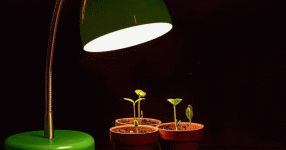
How to use grow light bulbs?
Grow lights are manufactured lights; used all year to assist in the growth of indoor plants. Grow lights are available in a range of color spectrums and light intensities to meet the demands of various plant species. Indoor grow lights are crucial gardening equipment that provides sufficient light for houseplants even in spaces without natural daylight.
Photons, sunlight particles that drive photosynthesis and enhance plant development, are converted into photons by grow lights. A diversity of frequencies that the naked eye sees as color; are the ideal light supplies for photosynthesis. Fruiting and blooming plants respond best to red light, whereas vegetative development is aided by blue light.
Types of grow lights
There are various kinds of grow lights for an indoor garden.
● Fluorescent grow lights: They come in various shapes and sizes, such as; tube lights and compact fluorescent lamps. While providing a broad beam of colors for plants, Fluorescent lights are more environmentally friendly than LED bulbs and can emit damaging heat.
● Incandescent grow lights: While some gardeners use incandescent bulbs, this form of grow light produces a lot of heat; and can damage plants. Incandescent lights are less expensive than other grow lights, consuming more power and burning out faster.
● LED grow lights: They have a prolonged life period than most other forms of grow lights. They are energy-saving and produce little heat. LED grow light bulbs and more prominent LED grow light fittings are the two most common types of LED lights.
● HID grow lights: HID grow lights best simulate direct sunlight; compared to other grow lights. These elevated lights are costly and are often seen in industrial grow facilities. High-pressure sodium lights, which generate a reddish color, and ceramic-metallic halide light cause a blue color ideal for seed beginning, are the two primary varieties of HID grow lights.
How to utilize grow lights
Use grow lights to make your indoor plants grow faster and more robust.
- Make selection of equipment: Choose the lighting setting that you believe would best suit your plants or flower garden. Ballasts are commonly used to adjust electrical outputs in fluorescent and HID grow lights. For most indoor plants, full-spectrum grow lights are a suitable choice. Try to use a brighter grow bulb, a panel of bulbs, or a mirror for extra light to approach the underside of branches if you have numerous seedlings.
- Prepare your lighting: The best lighting settings for your indoor garden are determined by the plants you possess. Even though some plants grow in poor lighting, most, especially succulents and blooming plants, prefer intense light.
- Keep an eye on the warmth of your lights: Grow lights can scorch seedlings relying on the power of your lighting. You should keep Incandescent lights two steps away from houseplants. Plants should be twelve inches away from fluorescent and HID grow lights. Due to the relatively low heat generation, LED grow lights may generally go as near as six inches to houseplants without hurting them.
- Set a timer for yourself: Consistent light output deprives plants of a natural sunlight cycle, causing them to suffer. Set a timer to control the quantity of light your plants get from your grow lights. Ensure that your plants receive around eight and sixteen hours of the morning and eight hours of nighttime each day.
- Please find out how much light each plant requires: Seeing a plant’s light requirements as filling a container is suggested. That container is overflowing with photons. The rate at which it fills; is determined by the strength of the grow light; the amount of natural light received by the plant. The containers for most plants are tiny; cabbage is more significant, while fruits and maturing tomatoes have quite huge containers. “Most vegetables are high-growing, full-sun plants.”
- Replicate the length of day that the plants are accustomed to: It won’t affect all plants, but it will do to some, particularly basil. Plants that originated in temperate climates can tell what season it depends on the duration of the darkness; therefore, a few of them blossom or cease blooming, dependent on the hours they experience light. However, material closer to the equator does not react since sunshine is twelve hours throughout the year.
- Don’t forget to keep hydrated: It is a misconception that succulents, such as; aloe, don’t like an amount of moisture. They usually don’t receive adequate sunshine to use all of the water. Moreover, keep seedlings wet all the time. If they appear to be spread with a lot of room around their toes, they require extra light.
- Maintenance and safety are both essential: Cleaning your lighting gear as required for maintenance is a brilliant idea, but do it with caution.
How to keep grow lights in perfect shape for long-term usage?
If you use your grow lights for a lengthy period, you need to set up a care system for your seedlings. You can’t just turn on the lights and turn on the water anytime you wish. Purchasing auto-flowering seedlings to aid in developing your plants might be an easy solution.
You may take it a step further by planning out when you will utilize your grow lights. It is essential to conduct some study to figure out the hours of morning your plants require at each phase of evolution. If you choose auto-flowering plants, you may watch them grow simply by leaving the lights on all the time.
After considering everything, you will be one step towards making a pleasant indoor gardening experience. The process requires concentration, but the outcomes will be worth all the effort!
For an indoor garden, grow lights are a vital alternative for sunshine. We have attempted to articulate and clear your doubts about using grow lights for houseplants. The proper understanding will make a huge difference and turn you into a pro-horticulturist in no time. Just go through the article and make yourself prepared for gardening!
Read more for: Best Electric Tiller Cultivator







